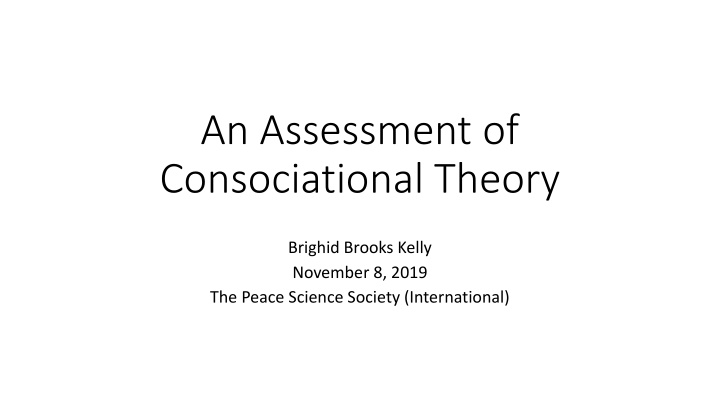
Assessment of Consociational Theory in Power-Sharing Systems
Delve into an assessment of the consociational theory by Arend Lijphart, exploring the system's components, favorable conditions, and its impact on stability in plural societies. The study includes empirical analysis and case studies to test the theory's claim that consociation promotes stability.
Download Presentation

Please find below an Image/Link to download the presentation.
The content on the website is provided AS IS for your information and personal use only. It may not be sold, licensed, or shared on other websites without obtaining consent from the author. If you encounter any issues during the download, it is possible that the publisher has removed the file from their server.
You are allowed to download the files provided on this website for personal or commercial use, subject to the condition that they are used lawfully. All files are the property of their respective owners.
The content on the website is provided AS IS for your information and personal use only. It may not be sold, licensed, or shared on other websites without obtaining consent from the author.
E N D
Presentation Transcript
An Assessment of Consociational Theory Brighid Brooks Kelly November 8, 2019 The Peace Science Society (International)
Consociationalism is A system of power-sharing & a theory regarding its likely success Described, Prescribed, and Refined by Arend Lijphart, beginning in the late 1960s Widely believed to be the only power-sharing system capable of preventing oppressive forms of majoritarianism and violence in deeply divided societies The System of Consociation is Comprised of 4 Components: Grand Coalition, Segmental Autonomy, Proportionality, Minority Veto The Theory of Consociationalism Includes a consistent claim regarding the system s function and a set of favorable conditions expected to facilitate its success This study tests this consistent claim, that.. Consociation Promotes Stability in Plural Societies
This Attempt to Assess Consociational Theory Includes the first large-scale, comparative, empirical analysis of this exact claim, prioritizing the precise, realistic representation of its elements Quantitative Findings are Further Explored Through Case Studies: Method 1) Quantitative Analysis of the Experience of 88 Plural Societies Between 1975-1995 Method 2) Comparison of Statistical Findings to 7 Case Studies Austria, Belgium, Canada, the Netherlands, Northern Ireland, South Africa, and Switzerland Inclusion in this case study section is not meant to imply that a society experienced consociation. Each case was chosen because it has been associated with consociational theory & its qualitative treatment will further our understanding of phenomena which could not be studied quantitatively.
Specifying the Precise Proposition to be Tested Lijphart s most consistent, precise claim regarding consociation was ascertained through meticulous examination of every mention of consociation by him, published by 2002. This proposition is: Consociation Promotes Stability in Plural Societies. Next, equally meticulous analysis enabled specification of his most consistent meanings of the terms, Stability and Plural. This resulting proposition is falsifiable. The terminology in it is very clear. It implies a scientifically sound methodology for detecting consociation in practice. The proposition does not include any claims related to cleavages or Lijphart s favorable conditions.
Defining Consociation Lijphart has always defined consociation as a governance system comprising these 4 core components: (1) Grand Coalition In Lijphart s (1977, p.25) words, grand coalition of the political leaders of all significant segments of the plural society. The presence of this component is represented through data indicating whether I was able to find evidence of such coalitions (there were very few). (2) Segmental Autonomy Lijphart (1977, p.41) describes it as rule by the minority over itself in the area of the minority s exclusive concern. He explains that it can manifest itself as a formal territorial federal system, a non-territorial federation, or a system in which decision-making is delegated to private segmental organisations (Lijphart, 1989, p.141). Different perspectives on how to identify such empowered segments are sometimes cited as precluding the scientific analysis of consociational theory. This project eliminates that issue by adopting a list of minorities used by a study not designed to test consociation. This component is represented through data indicating whether I was able to find evidence of such autonomy.
Consociations Remaining Components (3) Proportionality Lijphart (1977, p. 25) defines this use of proportionality as the principal standard of political representation, civil service appointments, and allocation of public funds. He implies it refers to political results, rather than specific electoral formulas. Unfortunately, a lack of necessary data regarding other forms of proportionality means that this component can only be represented in this study through data indicating electoral system proportionality. (4) Minority Veto Power Lijphart (1977, p.38) explains that this can be manifested in either formal, legal form or as an informal and unwritten understanding. It may be incorporated as a requirement for consensus or some proportion of representatives agreement. Data could not be compiled for this study indicating informal understandings. The constitutions used by 88 countries between 1975-1995 were read in their entirety to search for legal requirements for minority veto power.
Methodology for Quantitative Representation of Consociational Components Lijphart (1985, p.503) maintains that consociational power-sharing "cannot work well- and certainly not optimally- if one or more are missing. However, scientifically sound, quantitative testing of consociation could only be conducted using separate variables corresponding to the four components. This data indicates that only 3% of plural societies 1975-1995 are fully consociational. This tiny sample would not yield scientifically credible results. Extensive debate has involved the components individual roles so this methodology sheds light on many controversial issues.
Consociational cases in plural societies between 1975-1995 whose existence is confirmed by this dataset: Dark Blue: 3% of the years of experience covered by dataset: 5 Points indicating very consociational: Belgium (1978-1995), Madagascar (1993-1995), Nigeria (1980-1983), South Africa (1995), Switzerland (1975-1995) Light Blue: 4 points: Afghanistan (1989-1991), Ethiopia (1992-1995), India (1975), Lebanon (1991-1995), Malaysia (1975-1995), Netherlands (1975- 1977). Also in this category are Belgium (1975-1977), Madagascar (1976-1992).
Defining Plural and Identifying Cases Lijphart s descriptions of plural societies suggest that they are divided along cleavages involving religion, language, culture, ethnicity, and/or race, but not ideology. He suggests that plural societies contain clearly separate and potentially hostile population segments. Gurr s Minorities at Risk (MAR) dataset defines its groups as very similar to Lijphart s plural societies. Gurr s criteria for identification of MARs is their fulfillment of one or both of these criteria: 1. The group collectively suffers, or benefits from, systematic discriminatory treatment vis- - vis other groups in a state. 2. The group was the focus of political mobilization and action in defense or promotion of its self-defined interests at some time between 1945 and 1989. To eliminate potential bias related to consociation in the selection of cases, this study includes every country in Gurr s dataset whose MARs collectively comprise at least 10% of their overall population. (Some societies of particular interest to consociational theory, which were not included because they were not countries or were not identified as possessing such minorities, are analyzed as case studies). For instance, Northern Ireland is not a country so it could not be analyzed as its own case.
Defining Stability Lijphart consistently describes stability as consisting of: System Maintenance Civil Order Legitimacy Effectiveness Two of these cannot be incorporated into the dependent variable because their inclusion would jeopardize methodological soundness: System Maintenance : Lijphart believes that, in the best case scenario, consociation will evolve into a slightly more competitive system and render some conflict mitigation techniques obsolete. He believes that a system can remain consociational even if governance mechanisms change. Data which would indicate system maintenance are too closely related to independent variables to yield worthwhile statistical results. Like other scholars, Lijphart considers effectiveness to be efficiency of policymaking. According to this definition, consociation is inherently less effective than many other governance systems because it requires more time-consuming, power-sharing, decision-making processes. Thus, inclusion of effectiveness would predispose this analysis to indicate that majoritarian systems are more stable.
The Favorable Conditions Identified By Lijphart (All of which would ideally have been represented through control variables) Introduced in 1968 Introduced in 1977 Distinct lines of cleavage between subcultures Segmental isolation and federalism A multiple balance of power among the subcultures Small country size External threats Overarching loyalties A relatively low load on the system Moderate multiparty system Moderate nationalism Representative party system Popular attitudes favorable to government by grand coalition Crosscutting cleavages (in some instances) Tradition of elite accommodation Introduced in 1969 Widespread approval of the principle of government by elite cartel The length of time a consociational democracy has been in operation Introduction in 1985 Internal political cohesion of the subcultures Geographical concentration of segments Adequate articulation of the subcultural interests No majority segment plus segments of equal size Small population size Small number of segments Socioeconomic equality *These conditions and the terms used to describe them were contributed by Matthijs Bogaards (1998, p.478).
List of Variables Independent Variables: 1. Somewhat Inclusive Grand Coalition: Can I find evidence that one or more MAR groups, which do not comprise all of their country s MAR groups and are not identified as advantaged in Gurr s dataset, are represented in the governing executive? 2. Highly Inclusive Grand Coalition: Can I find evidence that all of a country s MAR groups, which may be only one and are not identified as advantaged in Gurr s dataset, are represented in the governing executive? 3. Segmental Autonomy: Can I find evidence that MAR groups had the power to govern some aspects of their lives autonomously? (restrictions on cultural organizations, official language status, legal autonomy, homogeneous governance units) 4. Minority Veto: If it is assumed that MAR groups can gain representation in legislative bodies in proportion to their sizes, does their country s constitution indicate that they could possibly exert a veto resulting in a changed policy decision? 5. Proportional Representation: If there is electoral competitiveness, is a Proportional Representation system used? Control Variables (Primarily Favorable Conditions ): 1. External Threats: How big is the spread of ethnopolitical rebellion throughout the region surrounding each country? 2. Moderate Multiparty System 3. Geographical Concentration of Segments 4. Population Size 5. Socioeconomic Equality 6. Democracy Dependent Variable: Stability: This variable was designed to represent the two elements of Lijphart s definition of stability that could be included: Civil Order & Legitimacy Stability is represented with summed data taken directly from four variables in the Minorities at Risk (MAR) dataset. These variables involve protest and rebellion.
Main Statistical Findings Following Multiple Regressions, Scatterplots, and Factor Analyses 1. Elements of consociation do affect stability in plural societies. 2. Highly inclusive coalitions deter instability. 3. Instability is exacerbated by the variables representing.. Somewhat inclusive coalitions Potential minority veto power Proportional representation electoral systems However, in regression analyses with all of the control variables, potential minority veto is the only variable corresponding to a consociational component which is found to still exert a statistically significant detrimental effect. Factor analysis results support Lijphart s belief that consociations are not inherently less stable than more majoritarian democracies.
Drawbacks of this Dataset Fearon and Laitin (2003, p.3-5) point out a number of drawbacks of Gurr s MAR dataset, which impact this project: 1. The criteria for identification as MARs are arguably subjective, sometimes contestable, and unclear. 2. Smaller groups are underrepresented and they might be less actively belligerent so the set of cases may overrepresent more belligerent groups. Drawbacks involving the methodology for MAR selection do not seem to introduce any consistent bias in this study s dataset. Cyprus and Northern Ireland have had consociational experience and had to be excluded due to issues related to the MAR dataset. Yugoslavia s experience between 1992-1995 also had to be excluded because it no longer fit the requirement that a case be a country. Austria, Belgium, and the Netherlands no longer contained sufficient amounts of MAR populations when Gurr s dataset was compiled so they are excluded from the quantitative portion of this project. A lack of some optimal forms of data for representation of the consociational components
Canada One of the oldest continuous parliamentary democracies, recently facing a possibility of destabilizing secession by Quebec A survey of relevant polls suggests that roughly 50% of Quebec s population favor the province s secession (approximately 12% of the Canadian population as of 2011). Secession through legal means is unlikely because constitutional change requires majoritarian consent of all of the provinces. Particularly since 1982, consociation has given way to almost complete majoritarianism. Quebec is treated as just another province and individual rights are prioritized. Transition to greater majoritarianism can be gradual It cannot be assumed that group members will advocate for their groups if they are not in grand coalition executives and are elected through majoritarian systems. Lijphart s favorable conditions are influential: Canada has not achieved sufficient overarching loyalty to a shared state. Canadian experience illustrates that external threats can manifest themselves as externally directed loyalties. Quebec s historical homogeneity decreases incentives for cross-group political consideration.
Belgium Segmental autonomy so extensive that it may prompt destabilizing secession Since Belgium became a state in 1830, consociational components have been applied to discourage instability between Dutch and French speaking regions. Cross-cutting cleavages have become increasingly congruent. Segmental autonomy, granted to maintain stability, inspired adoption of federalism and increasingly extreme decentralization to homogeneous regions. No politicians seek support from the country as a whole. Elites hold more extreme positions regarding group autonomy than constituents, apparently because of inadequate incentives for cross-boundary political appeals. The Swiss system also delegates substantial power to relatively homogeneous regions. It has achieved much more stability and it has greater overarching loyalty & incentives for cross-cleavage political appeals.
Switzerland As consociational as Belgium but more stable Historically a wide variety of cleavages but a linguistic, ethnic cleavage became dominant in the second half of the 20th century Federalism organized through historically delineated governance units which are mainly homogeneous but are also cross-cut by cleavages Stability has been maintained through consociation & incentives for intergroup political consideration 2 of Lijphart s favorable conditions have facilitated the success of consociation there: Historically cross-cutting cleavage structure in geographically delineated federal units Strong overarching loyalty to the Swiss governance system Lijphart identifies a tradition of deference to elites as a favorable condition However, Switzerland uses referendums by far more often than any other Western democracy 100,000 can propose a constitutional amendment requiring a referendum This promotes cross-cutting appeals & empowers the voters to send messages to their politicians (who are more moderate than their Belgian counterparts) Culturally related referendum questions would logically increase intergroup tension but my survey of Swiss referendum topics indicates that they do not involve the cultural autonomy of the German, French, or Italian groups, comprising the currently dominant cleavage.
Netherlands The inspiration for Lijphart s theory of consociationalism A cultural tradition of power-sharing began with orthodox Calvinists in the 19th century, who yearned for isolation within a shared, stable state. Lijphart observes that the firm divisions and elite cooperation began to diminish from the 1960s and that consociation became superfluous. A growing focus on individualism and acceptance of more majoritarianism was encouraged by long-term security of group based interests. Dutch stability was facilitated by the favorable conditions of cross- cutting cleavages and overarching loyalty to the governance system.
Northern Ireland compared to South Africa Two divided societies for which consociation was prescribed to promote stability Northern Ireland South Africa Grand Coalition: Yes Completely equal executive power The executive leaders were, but are no longer, elected together by a parallel consent, cross-community procedure. Proportional Representation: Yes Single Transferable Vote Proportional Representation (STV) in six member constituencies STV asks voters to rank candidates & their chosen candidates need not be from the same party. Segmental Autonomy: Yes Linguistic and educational group autonomy exists and additional cultural autonomy is likely to be granted in the future if requested. Minority Veto: Widely available Special majorities, large enough to allow for minority veto by the main groups, are required to pass certain categories of legislation in the Assembly. Since 2007, a minimum of 3 ministers can request a cross- community vote when no consensus can be reached within the executive about an issue. Grand Coalition: 1994 Interim Constitution: Not in practice No requirement for the president to gain the consent of any executive deputy president for any course of action. 1997 Permanent Constitution: Definitely not Proportional Representation: 1994 Interim Constitution: Yes Closed list proportional representation using the whole country as one huge multimember constituency 1997 Permanent Constitution: Yes Retained that system Segmental Autonomy: 1994 Interim Constitution: Possibly some 1997 Permanent Constitution: Less There is no category of legislation passed by the National Council of Provinces that cannot be rejected by the National Assembly, which has been dominated by one party. Minority Veto: 1994 Interim Constitution: Very little 1997 Permanent Constitution: Very little Limited to the requirement of a 75% majority for constitutional amendments.
Insights learned from South Africa and Northern Ireland South Africa s use of the closed list proportional representation system favored by Lijphart for consociation emphasizes how it can aid one-party domination. Incentives for cross-community electoral appeals in Northern Ireland s STV proportional representation system suggest that it may facilitate consociation s promotion of stability, particularly when combined with electoral district heterogeneity. South Africa s decrease of consociationalism in its final constitution emphasizes the advisability of designing a system that can evolve to be more centripetal. Their comparison emphasizes the influence of external actors, related to Lijphart s favorable condition of external threats. South Africa s minorities not represented by the dominant party have not rebelled against their exclusion from power, presumably because it is not clear that any external actor would save them from being violently put down. Considering the extremely equitable system of power-sharing in Northern Ireland, and the legal means available for changing the region s constitutional status, it seems surprising that significant, at times violent, anti-state dissident activity is occurring. However, the United Kingdom or the Republic of Ireland will intervene in the event of destabilization. It appears that economic hardship could be one motivator of anti-system activity in Northern Ireland. This emphasizes the importance of Lijphart s favorable condition of socioeconomic equality & suggests that political representation of an economic left- right spectrum may somehow facilitate consociation s success in the future.
Conclusions Highly inclusive coalitions do promote stability in plural societies. Potential minority veto power has a destabilizing effect. The other consociational components were not shown to have a clear beneficial effect. Factor analysis confirms Lijphart s belief that consociations are not inherently less stable than majoritarian democracies. Transition from consociation to greater majoritarianism need not be destabilizing. These favorable conditions do profoundly impact consociation s operation: Overarching loyalty External loyalties and influences Cross-cutting cleavages Segmental isolation Factors promoting cross-group political appeals contribute to the stabilizing effects of the group empowerment and autonomy provided by consociational components. For instance, the moderating influences of referendums and the STV electoral system with heterogeneous constituencies complement consociation. As Lijphart observes, consociation can become superfluous if people decide that their group interests are adequately protected and they want to pursue their diversity of individual interests in a more competitive political system.

![Download Book [PDF] Changing the Game (Offsides Book 1)](/thumb/42244/download-book-pdf-changing-the-game-offsides-book-1.jpg)




















